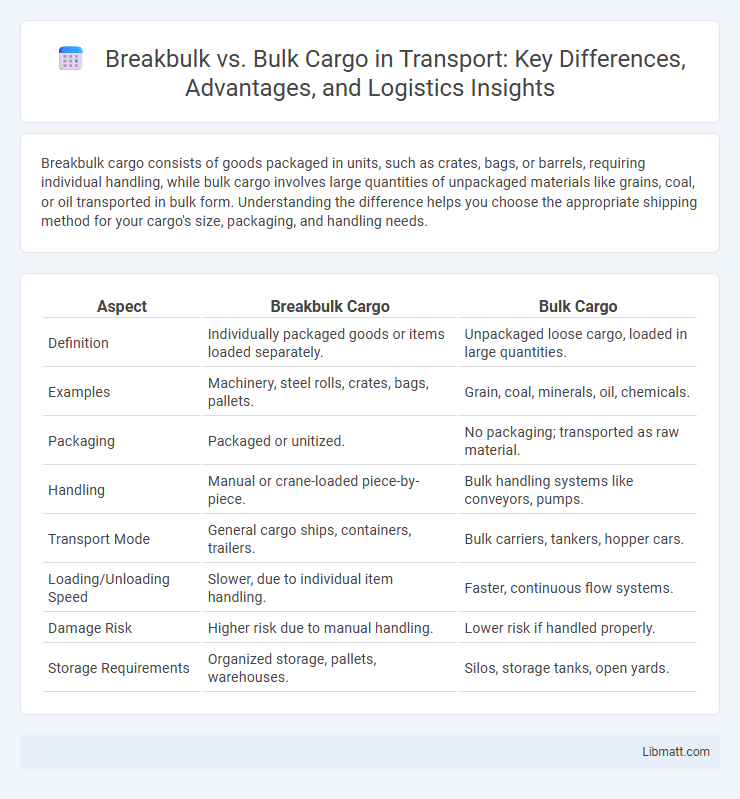Breakbulk cargo consists of goods packaged in units, such as crates, bags, or barrels, requiring individual handling, while bulk cargo involves large quantities of unpackaged materials like grains, coal, or oil transported in bulk form. Understanding the difference helps you choose the appropriate shipping method for your cargo's size, packaging, and handling needs.
Table of Comparison
| Aspect | Breakbulk Cargo | Bulk Cargo |
|---|---|---|
| Definition | Individually packaged goods or items loaded separately. | Unpackaged loose cargo, loaded in large quantities. |
| Examples | Machinery, steel rolls, crates, bags, pallets. | Grain, coal, minerals, oil, chemicals. |
| Packaging | Packaged or unitized. | No packaging; transported as raw material. |
| Handling | Manual or crane-loaded piece-by-piece. | Bulk handling systems like conveyors, pumps. |
| Transport Mode | General cargo ships, containers, trailers. | Bulk carriers, tankers, hopper cars. |
| Loading/Unloading Speed | Slower, due to individual item handling. | Faster, continuous flow systems. |
| Damage Risk | Higher risk due to manual handling. | Lower risk if handled properly. |
| Storage Requirements | Organized storage, pallets, warehouses. | Silos, storage tanks, open yards. |
Understanding Breakbulk and Bulk Cargo
Breakbulk cargo consists of goods transported in individual units such as crates, barrels, or pallets, requiring manual loading and unloading, while bulk cargo refers to large quantities of unpackaged materials like grain, coal, or oil moved in specialized vessels. Breakbulk cargo demands intricate handling and storage solutions to prevent damage, contrasting with bulk cargo that relies on efficient, volume-based transportation methods for cost-effectiveness. Shipping strategies and logistics vary significantly between breakbulk and bulk, impacting port infrastructure, packaging, and freight management.
Key Differences Between Breakbulk and Bulk Cargo
Breakbulk cargo consists of individually handled and packaged goods, such as crates, drums, or bags, whereas bulk cargo refers to unpackaged commodities like grains, coal, or oil transported in large quantities. Breakbulk requires specialized handling equipment and careful stowage to prevent damage, while bulk cargo is loaded using conveyors, pipelines, or grabs and stored directly in ship holds or tanks. The distinction impacts logistics, storage, and transportation methods, with breakbulk offering more flexibility for diverse shipments and bulk allowing efficient transport of homogeneous materials.
Types of Goods Transported: Breakbulk vs Bulk
Breakbulk cargo consists of individually packaged goods such as machinery, construction materials, and palletized items, while bulk cargo includes uncontained commodities like coal, grain, and petroleum transported in large quantities. Breakbulk requires specialized handling and stowage due to diverse packaging, whereas bulk cargo is typically loaded directly into ship holds or tanks. Efficient transport of breakbulk demands tailored logistics solutions, contrasting with the volume-driven processes used for bulk cargo shipments.
Loading and Unloading Processes
Breakbulk cargo involves individually handled items such as crates, bags, or barrels, requiring specialized equipment and manual labor for loading and unloading, often leading to longer processing times. Bulk cargo consists of unpackaged materials like grains, coal, or liquids, transferred using conveyors, pumps, or grabs, enabling faster and more automated handling. Your choice between breakbulk and bulk cargo significantly impacts the efficiency and cost of port operations due to their distinct loading and unloading methods.
Packaging Requirements for Each Cargo Type
Breakbulk cargo requires individual packaging such as crates, pallets, or barrels to protect items during handling and shipping, ensuring ease of loading and unloading. Bulk cargo typically involves unpackaged goods like grains, coal, or liquids transported in large quantities within specialized containers or tanks, emphasizing containment efficiency over individual protection. Packaging requirements for breakbulk prioritize durability and individual item security, while bulk cargo relies on containment systems designed for mass transport.
Cost Implications of Breakbulk and Bulk Shipping
Breakbulk shipping typically incurs higher costs due to increased handling, packaging, and labor requirements compared to bulk cargo, which benefits from economies of scale with uniform, unpackaged goods like grains or coal transported in large quantities. Breakbulk cargo demands specialized equipment and longer loading times, raising port fees and overall logistics expenses. Bulk shipping optimizes cost efficiency through standardized processes and faster turnaround, making it preferable for high-volume, homogenous products.
Advantages and Disadvantages of Breakbulk Cargo
Breakbulk cargo offers the advantage of flexibility in handling diverse and oversized goods that cannot be containerized, facilitating transport of heavy machinery, construction materials, and project cargo. Its major disadvantage lies in higher handling costs and increased risk of damage compared to bulk cargo, which is transported in large quantities without packaging, typically reducing labor and packaging expenses. Breakbulk also allows for easier inspection and sorting, but this often results in longer loading and unloading times, impacting overall efficiency.
Advantages and Disadvantages of Bulk Cargo
Bulk cargo offers advantages such as cost-efficiency and ease of handling for large quantities of loose materials like grains, coal, or minerals, making it ideal for high-volume shipments. However, it also presents disadvantages including the need for specialized equipment, risk of cargo contamination, and limited flexibility in packaging, which can impact the protection and value of your goods. Understanding these factors helps optimize logistics decisions when choosing bulk cargo for your transportation needs.
Choosing the Right Shipping Method
Choosing the right shipping method depends on the type of cargo and its handling requirements. Breakbulk cargo consists of individually packaged goods, often heavy or oversized, requiring specialized equipment and careful loading, while bulk cargo involves loose materials like grains or minerals transported in large quantities without packaging. Understanding the nature of your shipment helps determine whether breakbulk or bulk shipping offers greater efficiency, cost-effectiveness, and safety for your cargo.
Future Trends in Breakbulk and Bulk Shipping
The future of breakbulk shipping is increasingly influenced by digitalization and automation, enhancing cargo tracking and handling efficiency for diverse, irregular-sized goods. Bulk shipping trends emphasize sustainable practices, with innovations in fuel efficiency and reduced emissions to meet global environmental regulations. Integration of smart technologies and green solutions is expected to reshape operational models and cost structures in both breakbulk and bulk cargo sectors.
breakbulk vs bulk cargo Infographic

 libmatt.com
libmatt.com